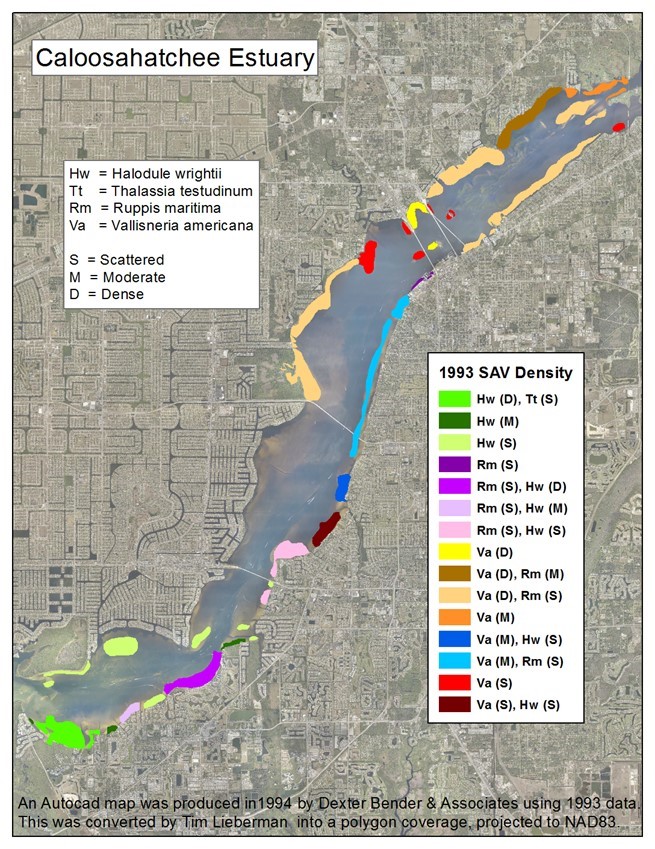Restoring habitats in South Florida can get an early start by implementing the right projects ahead of the larger scale restoration projects that have recently captured the headlines. With a 30-acre project in the Caloosahatchee River, SGF aims to show the far reaching benefits through a habitat project design that is built to succeed, now and for the long haul.
SGF has published numerous articles that point out the many benefits of sea grass in our estuaries. The various species of grass help stabilize flats and protect from erosion, they provide nursery habitats for uncounted species of fish and other animals, they filter water and trap sediment, and more. But what about the eel grass/tape grass in the freshwater systems that feed directly into our estuaries?

As you might guess, tape grass serves the same functions on the freshwater side of our estuaries, where snook and other gamefish forage and their young seek refuge.
Restoring tape grass, Vallisneria americana, in critical places within systems such as the Caloosahatchee and the Indian River Lagoon can help get our interconnected ecosystems back on track. Unfortunately, for a variety of reasons, this can not be accomplished by simply dropping seeds or even transplanting plugs.
With that in mind, SGF has partnered with Johnson Engineering, Inc., and Sea & Shoreline Aquatic Restoration to implement a project that is based on practices which have proven to be successful where others have failed. By first selecting the best strain of tape grass (native to Florida), then planting plugs in strategic locations and then protecting those plugs from grazing animals such as turtles and manatees, and monitoring for success over a period of a few years, SGF is confident that a proposed project to restore 30 acres in the Caloosahatchee will be successful, and now is the time to make it happen.
Protecting the plantings long enough to reach sexual maturity is a key element of the project. Female flowers and seed pods are only produced when plants are allowed to grow ungrazed to about 30-36 inches in height. The scope and scale here will provide adequate grass so once the cages are removed, natural grazing will not just wipe it out. "This system has suffered greatly for a variety of reasons," said David Ceilley, Senior Aquatic Biologist at Johnson Engineering, including droughts, engineered water flow and nutrient overloads. Therefore, restoration is not a simple process or it would have already occurred. "We've demonstrated success in the past with several pilot projects in the Caloosahatchee, and on a larger scale in areas such as Kings Bay of Crystal River, FL, where conditions are equally complicated.

"This initial project, which will be funded by the State, is just our first step," says Pete Quasius, Vice Chair of SGF's Board of Directors. "It will serve as a springboard for us to seek other funding sources so we can replicate the project throughout the Caloosatchee basin as well as other locations in Florida."
The project will cost around $1 million, which will include the cost of growing the plugs, building and installing underwater cages to protect the plants from herbivory (grazing), and long term monitoring. The habitat restoration project has been approved by both Florida's House and Senate, and now only waits for the Governor's approval.
Once approved by the Governor, SGF will administer the project and immediately begin seeking other funding sources to expand the footprint. "The value of this project far outweighs the cost," said Mike Readling, SGF Chairman. "Numerous studies have placed the value of an acre of eel-grass at such a level that the local economy will see a 7-10 fold return on the investment." This is partly why this project has support from Ft. Myers mayor Randall Henderson, the Ft. Myers City Council, The Charlotte Harbor National Estuaries Program (CHNEP), and many others.
Readling said he believes that SGF can help demonstrate just how diverse the benefits of this kind of restoration project can be. "Restoration is such a complex issue, and we need to make sure we keep the entire ecosystem in mind as we move forward. As we fight battles across the entire environmental arena we sometimes become focused on a single segment such as water quality or a particular species. This project will have benefits across the spectrum of restoration."
Open configuration options

